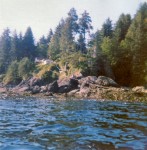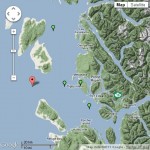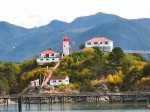
The landing under the hook (aka highline) at Kains Island was a large basin at the back side. It looked like a very large boulder had been washed out from the hole. It was a bit tricky if the swell was running to bring the station inflatable in safely but we never had a accident in my three years on station.

After a SE winter storm the hole would fill up with kelp stems broken off the surrounding reefs by the large swells. The swells then pounded this kelp into a tan-coloured foam which drifted all over the ocean and blew up into the trees and hung there like lichen. It was quite light but sticky to the touch.
One winter day we were expecting the supply ship with groceries, mail, etc. One of the Coast Guard buoy tenders arrived rocking and rolling in the swells in Quatsino Sound. Over the side went the workboat and then began the process of off-loading the supplies into her. We could see the orange-suited crew members on deck and in the boat but could not recognize anyone.

As we watched the workboat pull away from the shelter of the ship we were called on the radio by an unknown voice that the boat was on its way in. We acknowledged and commented that this appeared to be a new mate. Always fun to see how much experience they had unloading under a highline.
The boat rolled across the half kilometer distance between us and the ship, sometimes disappearing completely in the swells. The mate brought the boat closer to shore and lined up with the small bay, all the while ploughing a path through the foam which was pushed aside by the bow. As the boat neared the gap the mate rode a swell in under the hook and all but completely disappeared!
We could see well from the winch shed and the highline deck but only heads were showing in the workboat – the rest had completely disappeared! During the night the storms had lashed the kelp to pulp and filled the gap with sea foam to almost a metre deep! The workboat rode in on the swell and right under the foam.

Pushing the foam aside, the crew grabbed the lowered hook, slipped on a set of slings and signalled Haul Away. As the bonnet sling left the well of the workboat it also left a nice clean spot in the boat. On landing on the highline deck above, it was discovered that everything was covered with the sea foam, but, all was OK on the inside of the cartons of groceries and bags of mail although a bit sticky on the outside. The foam, although appearing quite dense, was actually quite dry and no harm was done.
The mate was a little more cautious when he came in with the second load.
************************************
More information about the sea foam. Below is the content of an email I received in March 17, 2008.
HERE’S SOMETHING WE’LL NEVER SEE………WHIPPED OCEAN……..AMAZING!
Suddenly the shoreline north of Sydney was transformed into the Cappuccino Coast . Foam swallowed an entire beach and half the nearby buildings, including the local lifeguards’ centre, in a freak display of nature at Yamba in New South Wales .
One minute a group of teenage surfers were waiting to catch a wave, the next they were swallowed up in a giant bubble bath. The foam was so light that they could puff it out of their hands and watch it float away.
Boy in the bubble bath: Tom Woods, 12, emerges from the clouds of foam after deciding that surfing was not an option
It stretched for 30 miles out into the Pacific in a phenomenon not seen at the beach for more than three decades. Scientists explain that the foam is created by impurities in the ocean, such as salts, chemicals, dead plants, decomposed fish and excretions from seaweed. All are churned up together by powerful currents which cause the water to form bubbles. These bubbles stick to each other as they are carried below the surface by the current towards the shore. As a wave starts to form on the surface, the motion of the water causes the bubbles to swirl upwards and, massed together, they become foam.
The foam ‘surfs’ towards shore until the wave ‘crashes’, tossing the foam into the air.
Whitewash: The foam was so thick it came all the way up to the surf club
‘It’s the same effect you get when you whip up a milk shake in a blender,’ explains a marine expert. ‘The more powerful the swirl, the more foam you create on the surface and the lighter it becomes.’ In this case, storms off the New South Wales Coast and further north off Queensland had created a huge disturbance in the ocean, hitting a stretch of water where there was a particularly high amount of the substances which form into bubbles. As for 12-year-old beach goer Tom Woods, who has been surfing since he was two, riding a wave was out of the question ‘Me and my mates just spent the afternoon leaping about in that stuff,’ he said.
‘It was quite cool to touch and it was really weird. It was like clouds of air – you could hardly feel it.’
Children play among all the foam which was been whipped up by cyclonic conditions.












